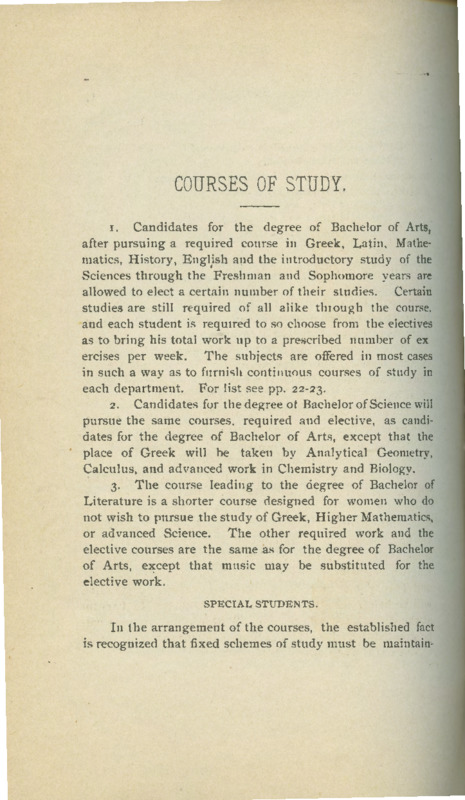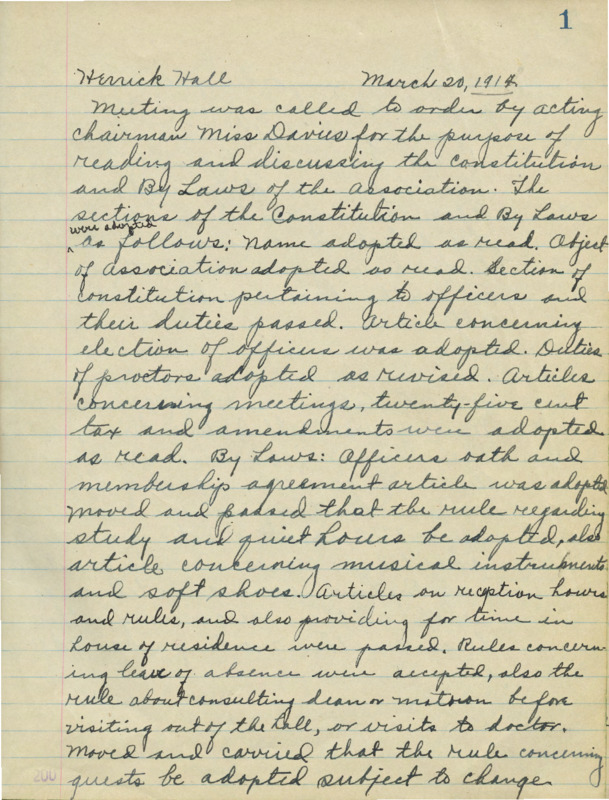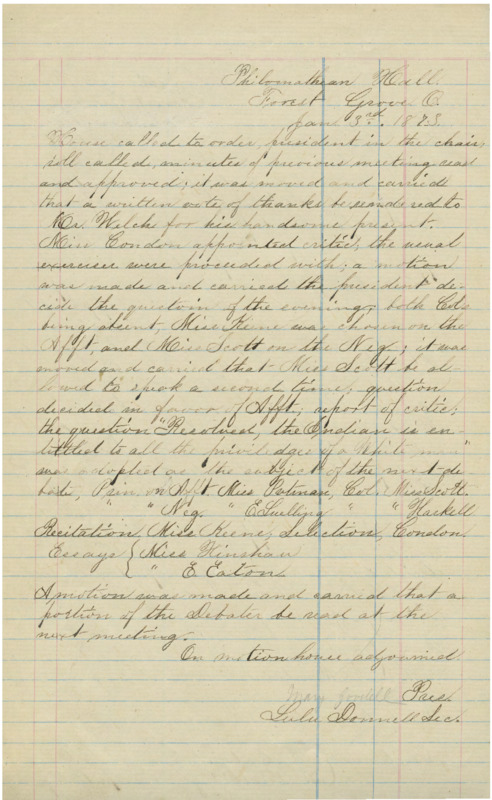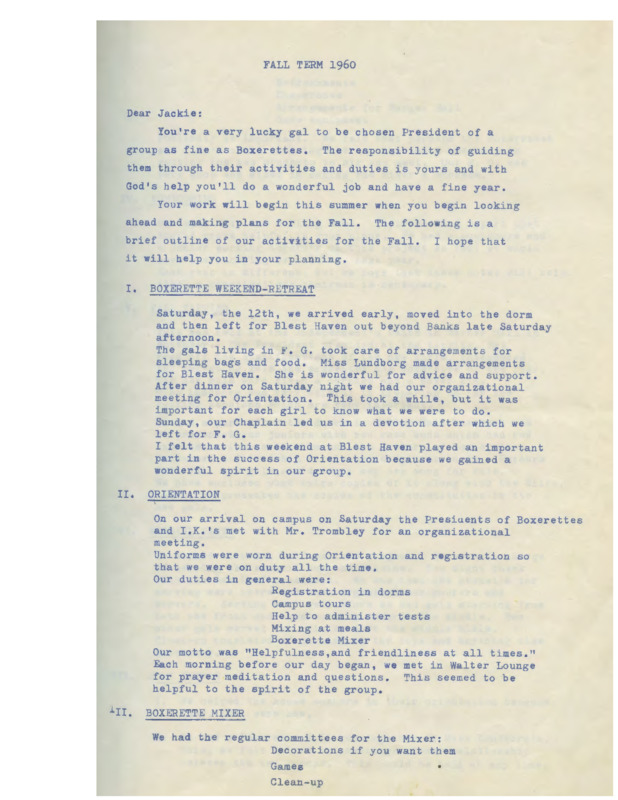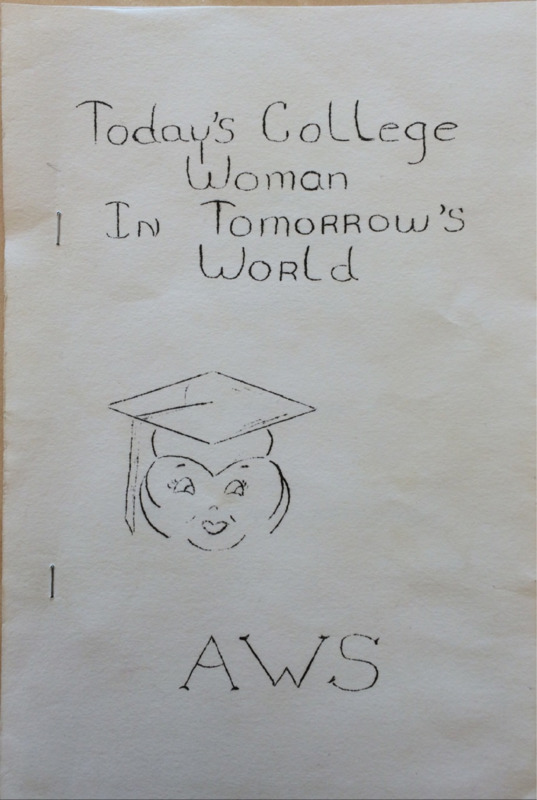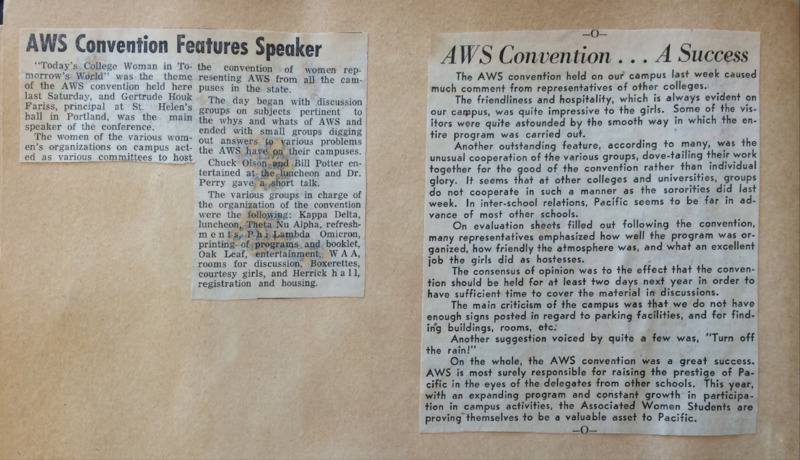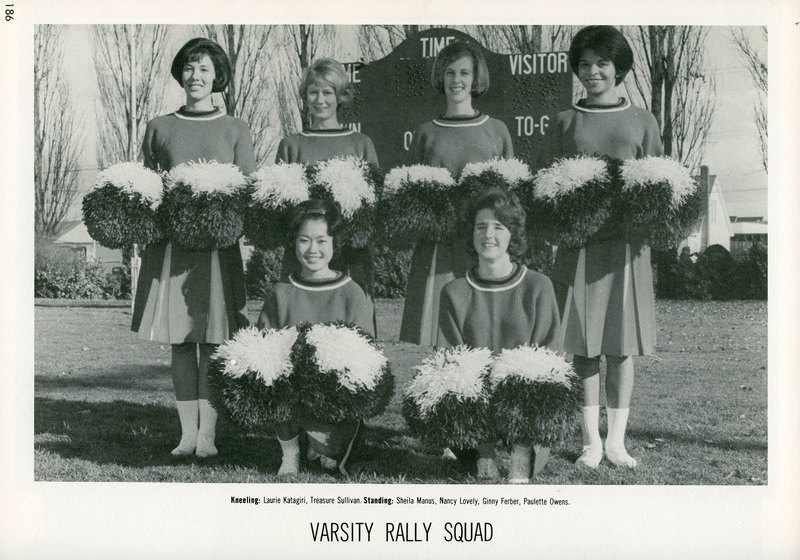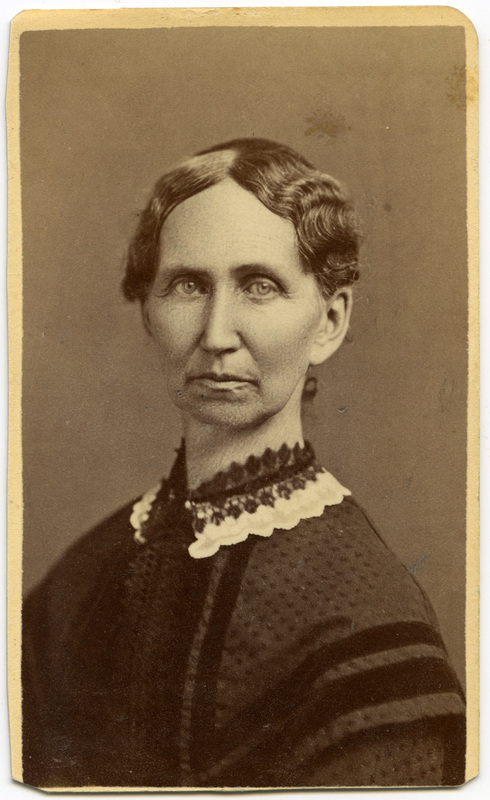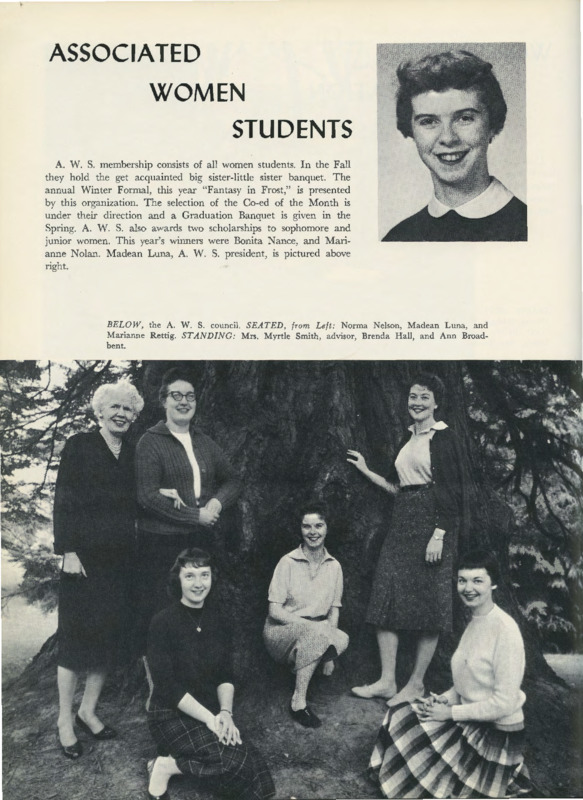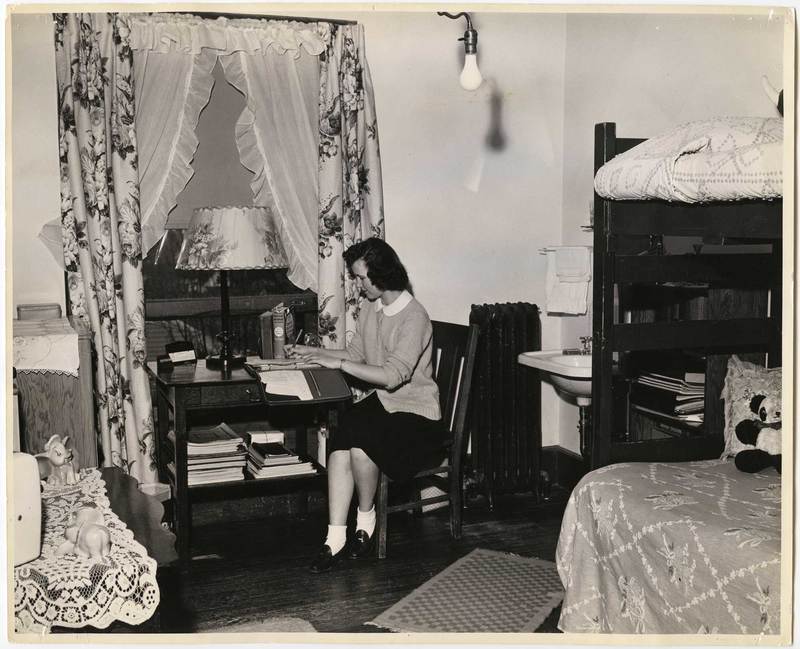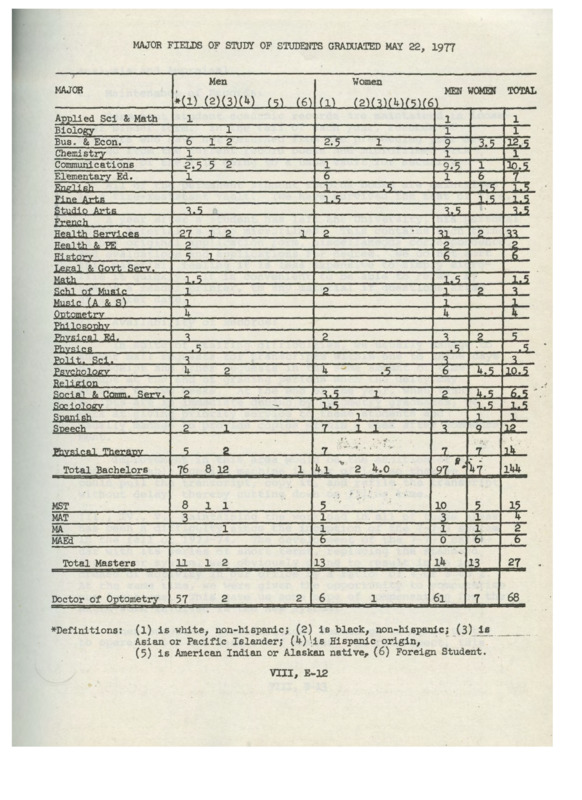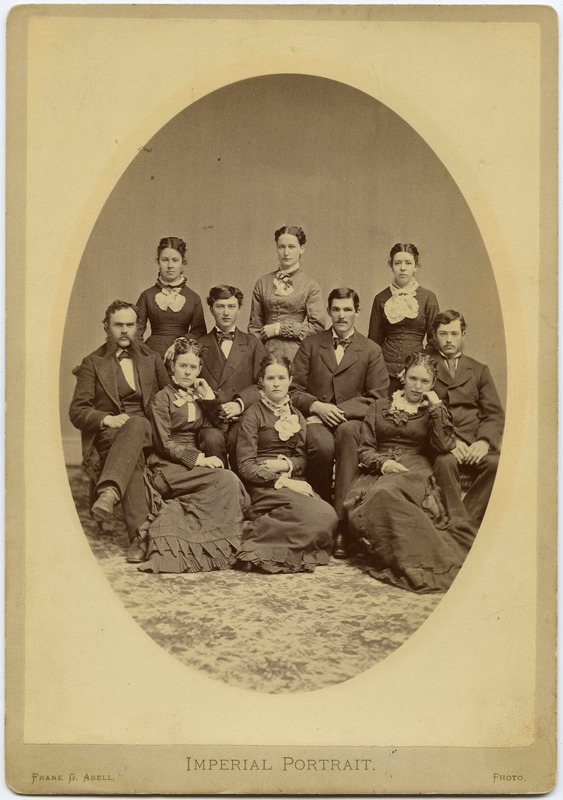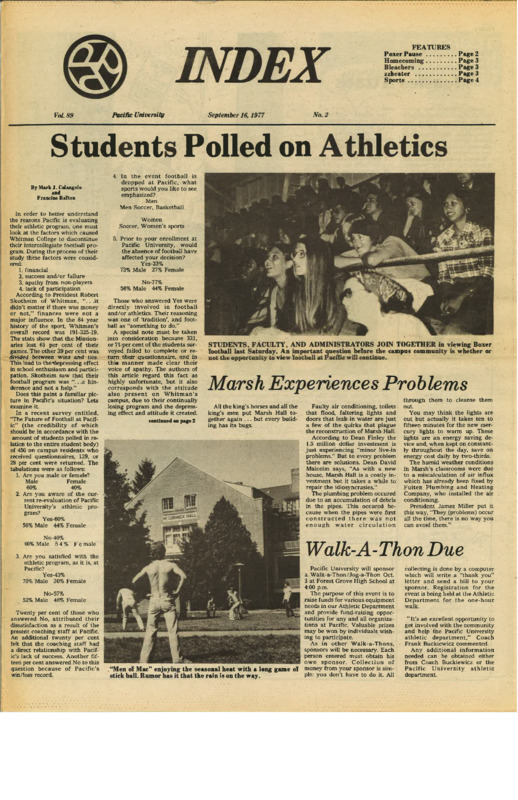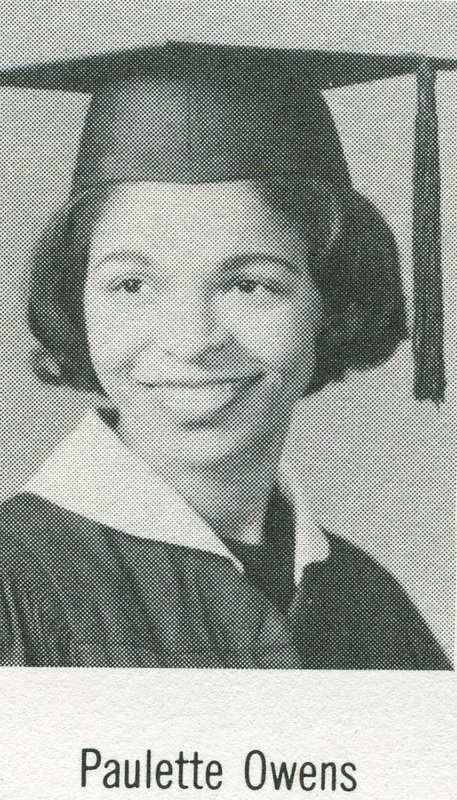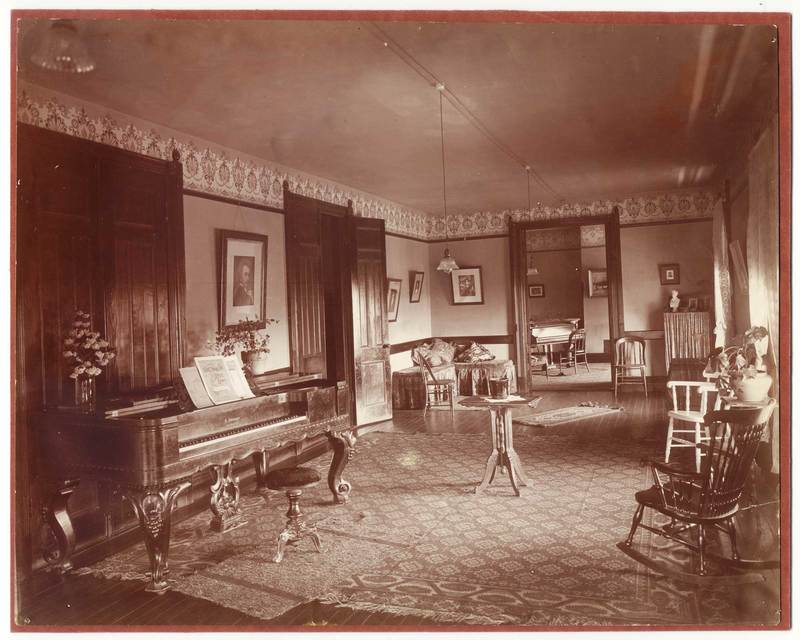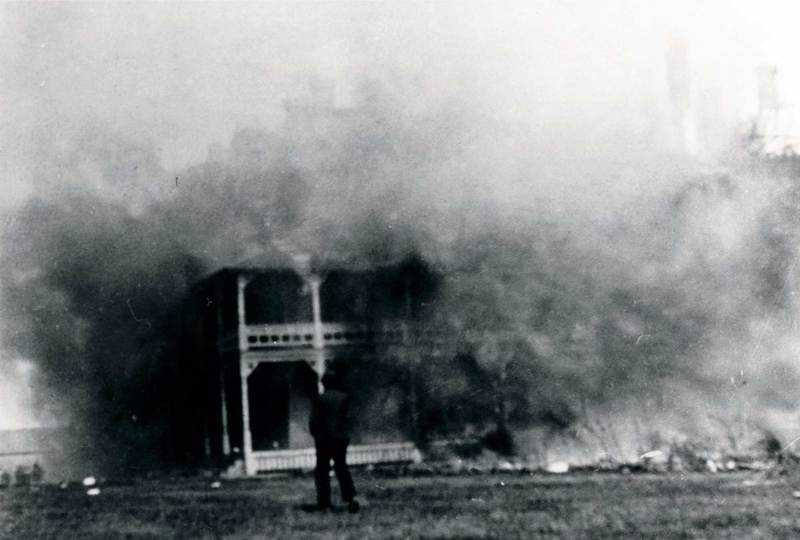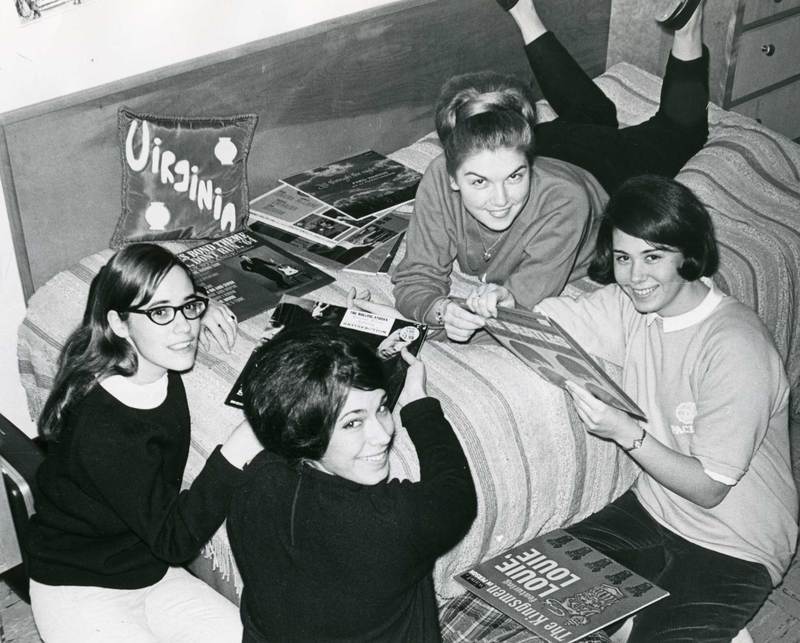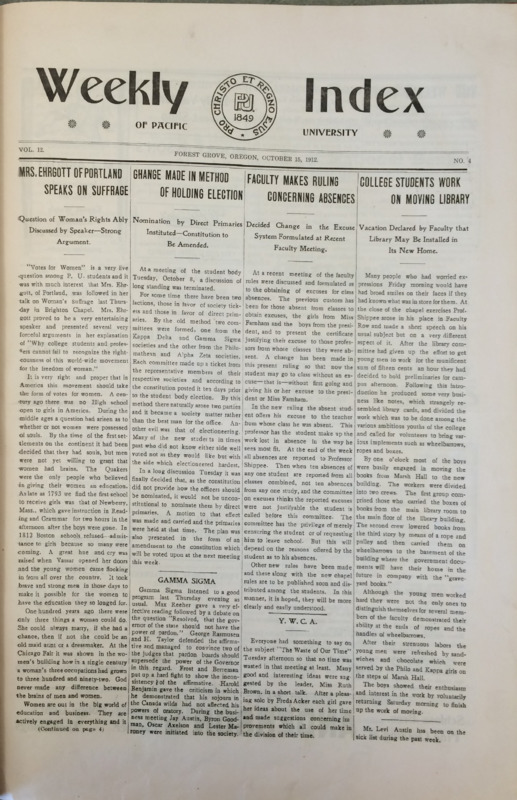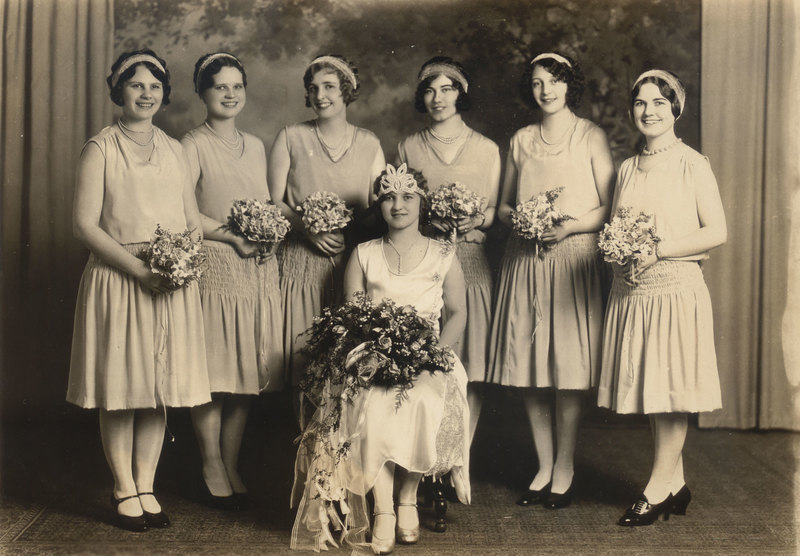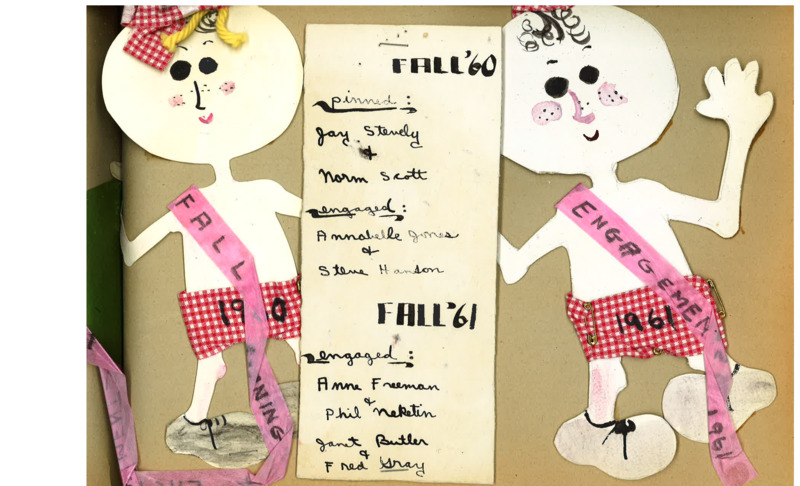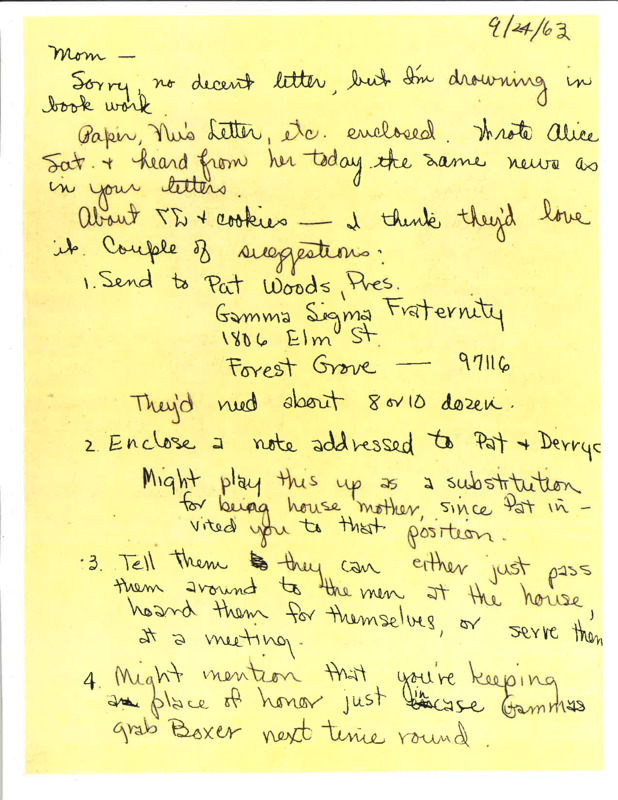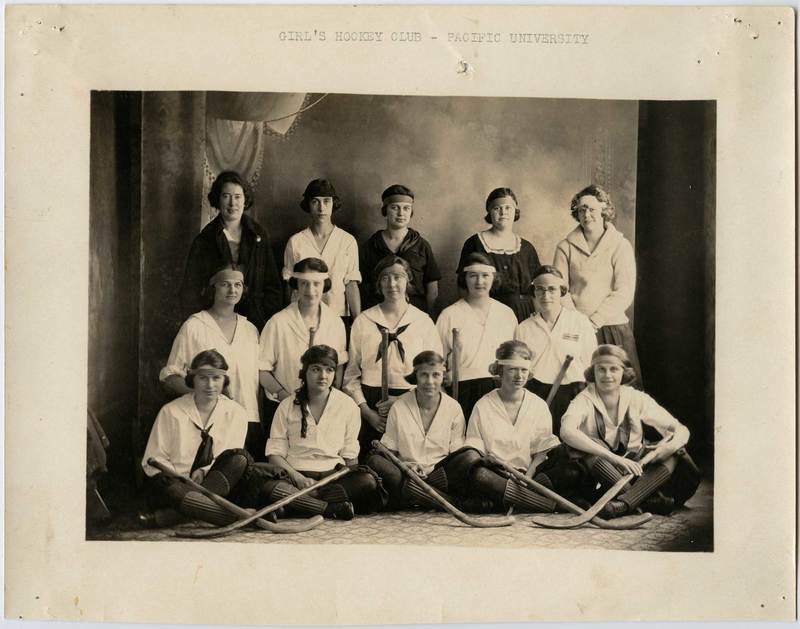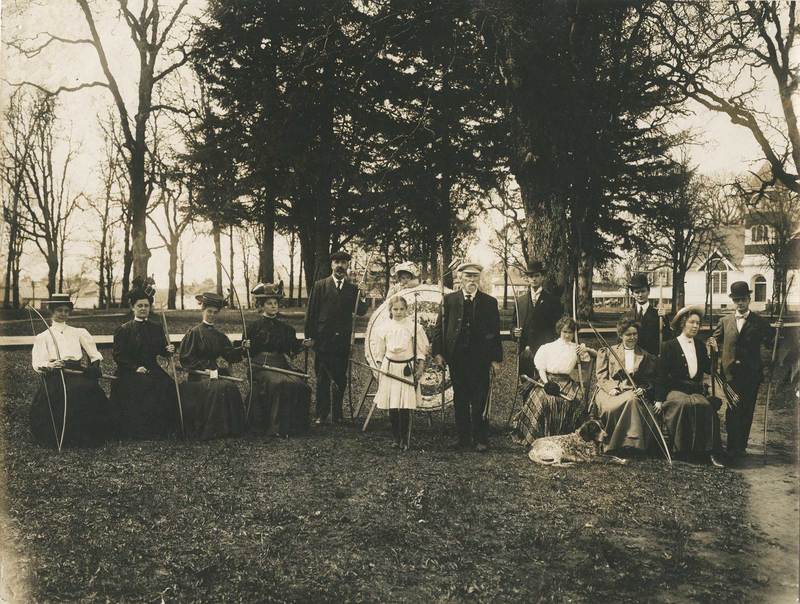Items
-
Courses of StudyThis is a Courses of Study introduction to a Study Catalog of Pacific University from the 19th century. It includes brief information on obtaining a degree in the bachelor of arts, sciences, and literature, as well as information on how to recieve a degree, students taking classes but not going for a degree, and in formation on teacher certificates.
-
Herrick Hall House Government Meeting MinutesThis text is the first entry in a book of meeting minutes taken by the Secretary-Treasurer for Herrick Hall at Pacific University that covers the time period March, 1914 to September, 1928. This entry was taken on March 20, 1914. The meeting minutes entry describes the meeting being called by chairman Miss Davies. Her full name is Hazel Mary Davies and in March, 1914, she was a junior from Astoria, Oregon. After graduating from Pacific University, she became a public school teacher in Astoria, Oregon. The student government for Herrick Hall at this time dealt with setting house rules with the Constitution and By-Laws, hosting dinners and dances for large events, holding fundraisers, and having officer elections. Some of the rules set in the constitution that were passed and revised in this entry describe study and quiet hours, usage of musical instruments and soft shoes, the setting of reception hours and rules, speaking with the dean or matron about leaving the hall, and rules regarding guests, room cleanliness, the missing of meals, lights, penalties, and the fines for missing meetings. The original all-female dormitory was first built in 1883 and was called Ladies Hall. During the second university president Reverend John Russell Herrick's tenure, he spent much of his four years as president away from the university, but in that time, he was able to accomplish many things including raising $16,000 to build Ladies Hall. The first year the building was put to use was in 1884. It was renamed after President Herrick in 1887. The first Herrick Hall completely burned down on Sunday, March 11, 1906, from chimney sparks on the roof. A combination of women's fundraising and the Carnegie Foundation donation of $10,000 allowed the second Herrick Hall to be built in 1907. Until 1958, it was still an all-female residence hall. Herrick Hall burned down a second time in 1973.
-
Philomathean Society MinutesThe Philomathean Society is a woman's Greek letter organization that was founded in 1871. Their members were, and still are referred to as Philos. In 1924, the group changed its name to the Phi Lambda Omicron Sorority, which is what it is referred to as today. In the 19th and early 20th century the organization mainly focused on debates, reading and music. The minutes from the weekly meeting of the Philomathean Society on January 3rd, 1873, written by secretary Lulu Donnel, include a description of calling the meeting to order, roll call, and approving the previous meetings minutes by the President, Mary Goodell. The document outlines the debate held at the meeting held between Maggie Keene, who argued the Affirmation, and Ella Scott, who argued the Negation. The topic they debated was, 'Resolved, the Indian is entittled to all the priviledges of a White man.' This document was extracted from a collection of the minutes of the Philmathean society from 1871 to 1879, written by hand in a single document.
-
Boxerettes Club Directions to Incoming PresidentA letter to the incoming 1960 Boxerette Presidnet, Jackie Holbert from the outgoing 1959 President, Barbara Boates. The Boxerettes were an honorary service organization made up of women from Pacific University. The letter discusses responsibilities and expectations for the incoming President as well an outline of the events that the group hosted the previous year. Some of the events included the Boxerette Weekend retreat, Freshman Orientation, the Boxerette Mixer, Homecoming, and the Wassail Holiday Party. The letter comes from the collection of documents, the Boxerette Review which contains various documents of the boxerettes from 1951 to 1966.
-
Associated Women Students Conference ProgramA four page program for the Associated Women Students Conference held on January 14, 1956. The theme of the conference was, 'Today's College Women In Tomorrow's World.' The main speaker at the conference was Gertrude Houk Fariss, who was the principal at St. Helen's hall in Portland. The day consisted of three allotted times for discussion groups that dealt with responsibilities and opportunities for women on college campuses. A.W.S also received help for running the conference from other service groups on campus including the Boxerettes, Theta Nu Alpha, Kappa Delta, Phi Lambda Omicron, and the Oak Leaf honorary Society.
-
News Articles on Associated Women Students ConferenceThe two articles from the Pacific Index which concerned the Associated Women Students Conference held in 1956 give brief descriptions of the outcome of the conference. The first article titled, 'AWS Convention Features Speaker' gives a very neutral description of the day. The article mentions the main speaker for the day, Gertrude Houk Fariss, the theme of the day, 'Today's College Woman in Tomorrow's World,' and a description of some other groups who helped and what they did which included, 'Kappa Delta luncheon, Theta Nu Alpha refreshments, Phi Lambda Omicron, printing of programs and booklet, Oak Leaf, entertainment, Boxerettes, courtesy girls, and Herrik hall, registration and housing.' The second article however was much more descriptive of how the conference was viewed by attendees and others. The article was titled 'AWS Convention... A Success.' It touched on the, 'friendliness and hospitality' as well as, ' how well the program was organized, how friendly the atmosphere was, and what and excellent job the girls did as hostesses.' The article doesn't talk about any of the discussions or speakers at the conference and mentioned how the only complaint was the rain. Both articles from the Pacific Index are in a scrapbook of the Associated Women Students.
-
Varsity Rally Squad PhotographA photograph taken of the Varsity Rally Squad at Pacific University in Forest Grove, Oregon. This photo was located at the Heart of Oak '65 yearbook of Pacific University. This yearbook was created by Pacific students and faculty. The Varsity Rally Squad members included: Laurie Katagiri, Treasure Sullivan, Sheila Manus, Nancy Lovely, Ginny Ferber, and Paulette Owens. These student athletes were very involved with not only sports, but also extra curricular activities such as clubs. These women participated in the athletic program when they supported the men's basketball and football games during competitions. There was not just a varsity group, but a junior varsity rally squad as well. This recognizes the fact that women's sports were now becoming more active and more women were becoming involved with athletics. This shows the progress of girls trying out to be part of the rally squad. There were two teams to potentially make. The rally squad during 1965 are equivalent to what a cheerleader is. They support, rally, and cheer on Pacific University. These women had practices like every other sport did, and performed. The rally squad was not always at Pacific University for athletics unlike sports like basketball, tennis, and volleyball. It slowly grew into an activity that women wanted to try out for and be a part of. This photo is significant because it shows the support in women's athletics and including various forms of athletics to include at the collegiate level such as the rally squad.
-
Photograph of Mary Richardson WalkerMary Richardson Walker was born April 1st, 1811. She grew up in Massachusetts as the oldest of eleven. In 1837, she meets Elkanah Walker. After only knowing each for 48 hours, they became engaged and were married a year later. Both being strong of faith and having a dream of being a missionary, they jumped at the chances to travel to Oregon Country as missionaries. They left on March 7th, 1838 with three other couples. They reached the Whitman Mission in August 29th, 1838. The Richardson’s then proceed to make a new mission called Tshimakain. The lived there for ten years. Shortly after the Whitman Massacre in 1847, then the Walker family decided to move to Oregon. Before long, the family became an eminent part of the Forest Grove community. The important thing to note about the Walker family was they were the ones who donated the land and a building in which Pacific University is established on. Elkanah also served on the board of trustees. Now the importance of Mary Richardson Walker cannot be easily overlooked. Not much is known of her true accomplishments, partly due to her gender. She wrote a diary of her entire journey through life. This journal is used today as an honest representation of life on the trail and once reaching Oregon. She is a true woman of the Oregon trail
-
In Memoriam. C0-Education of the SexesThis is the section of a Memoriam book for Dr. Marsh, whom died two years before the publishing date in 1879. The book describes how he changed the school's education system from not teaching female students, to teaching female students. While observing different teaching methods from different regions, he found that the society seemed to function better when both men and women were being taught in a similar environment, rather than separate from each other. The trustees, agreed that it was important to keep the humanity with the males sane and that having women in the school environment would be beneficial in general. Young Women were still considered to be famine rather than noble still within the eyes of the University trustees. For they did not consider the approval or thoughts of women when it came to this decision or even consult with women on the educational synopsis developed for women.
-
Associated Women Students 1959 Yearbook PageThe Associated Women Students 1959 yearbook page shows their Spring 1959 President, Madean Luna, as well as the A.W.S council, which included their adviser Mrs. Myrtle Smith. A.W.S. also selected a co-ed of the month as well as a co-ed of the year. The selection was based on achievement and involvement on campus. This page was taken from the 1959 Yearbook from Pacific University, Heart of Oak.
-
Dorm room in second Herrick Hall at Pacific UniversityThis is a photograph of a young woman named Jean Stephenson studying in her dorm room in Herrick Hall at Pacific University in February, 1947. Jean is from Metzger, Oregon, and was a sophomore at the time of this photo. Jean graduated from Pacific University in 1949 as valedictorian with a Bachelor of Arts in History. She later became a teacher, living first in southern Oregon and later moving to northern Oregon where she lived for the rest of her life until April 3, 2016. Herrick Hall was three stories tall with bathrooms on each floor with single and double-bedrooms lining the halls. Every dorm room in Herrick Hall was supplied with a sink, a heater, and furniture such as a bed, mattress, and a desk for each student. All women who did not have already have a home in Forest Grove were required to live in Herrick Hall. The original all-female dormitory was first built in 1883 and was called Ladies Hall. During the second university president Reverend John Russell Herrick's tenure, he spent much of his four years as president away from the university, but in that time, he was able to accomplish many things including raising $16,000 to build Ladies Hall. The first year the building was put to use was in 1884. It was renamed after President Herrick in 1887. The first Herrick Hall completely burned down on Sunday, March 11, 1906, from chimney sparks on the roof. A combination of women's fundraising and the Carnegie Foundation donation of $10,000 allowed the second Herrick Hall to be built in 1907. Until 1958, it was still an all-female residence hall. Herrick Hall burned down a second time in 1973.
-
1977 Pacific University Self-Study Reports ExcerptsThe Pacific University Self-Study Reports are a series of decennial reports that lay out University goals, collect and interpret data related to student admissions, graduations, faculty size increases, university finances and more. The reports can act as a valuable measure of race and gender related issues both in what they directly say and what is left out. The 1977 reports expresses racial and gender diversity as a main goal for the University. Specifically, this is expressed a 'maintain[ing]' an 'ethnic and social and coed mix of [the] student body.' On the twelfth page of the introduction attention is drawn to Black Culture Week and the Hawaiian Luau which are considered 'grand celebrations' of minority culture. Having an excess of 20% of students as minorities is considered an indication of achieving University goals. Rather than expressing a goal to diversify the mix of students, or increase acceptance of minorities, the goal is explicitly to 'maintain the mix'. Section VIII, E-12 shows the number of graduating students in May '77 broken down by major field of study, gender and racial background. This was the first time race and ethnicity was reported in these self-studies, but this practice would not be followed in the '87 and '97 reports. The documents featured show important statistics about the portion of women undergraduate and graduate students who were minorities.
-
Pacific University Graduating Class of 1878, PortraitThis is the portrait of the graduating class of 1878 at Pacific University. The majority of students graduating are female and they are arranged in the portrait as follows.First Row; Mary A. (Creswell) Eagan later Simard, Elvira H. Fearnside, Laura M. (Haxter) Wholley: Second Row; DeWitt Clinton LaTourette, Milton W. Smith, Samuel R. Stott, Horace Sumner Lyman: Third Row; Mary F. (Lyman) McCoy, Ellen (Scott) Latourette - Mrs. D.C., Mary Stacey Eaton.
-
'Students Polled on Athletics' IndexThis item is a newspaper article that came out of the Index of Pacific University about the students polling on athletics. The writers of the article was Mark J. Colangelo and Francine Raften. The article was written in 1977. The article subject is about the issues that students saw in the athletic program. In the polling process it is very evident that women were very unsatisfied with sports at this time. Interesting enough this is 5 years after Title IX was passed, so it would seem that not much has changed in response, even though women were participating in sports during 1977. Women were involved in competition, participating in sports, and were part of a team. Women were involved in gymnastics, soccer, tennis, track, volleyball, and even basketball. There were equal to men, but even after the passing of Title IX women were still unsatisfied at Pacific University. The polling article greatly stressed the percentages of the polls and how 70% men were satisfied with the program whereas women were 30% satisfied. This article is significant because even after the pass of Title IX where women are suppose to equal to men in athletics, there were still issues for women. This entails how long the process was for women to be recognized fairly in the same light as men and gaining the respect of being a female athlete. This article is very significant because it shows retrogression in Title IX instead of progress at Pacific University based on the polling results of the athletic program.
-
Paulette Owens Portrait 1965 Yearbook PhotoGraduated in 1965 in Psychology. member of phi lambda omicron sorority, the Pan-Hellenic Council, Pacific University Singers, the Student Anti-Discrimination League, and the Varsity Rally Squad. Paulette would go on to study and practice law in New York City and would return to Pacific during the 1983 Homecoming-Inauguration Convocation and received an Honorary Degree at Pacific with her twin Paul Owens. She may have been the first black woman to graduate Pacific's undergraduate program.
-
Parlor in Second Herrick Hall at Pacific UniversityThis is a photograph of the parlor in the second Herrick Hall. This was a gathering place on the first floor of the building for women while living in this residence hall. Women were required to live in this building while attending Pacific University if they did not already own a home off campus. The original all-female dormitory was first built in 1883 and was called Ladies Hall. During the second university president Reverend John Russell Herrick's tenure, he spent much of his four years as president away from the university, but in that time, he was able to accomplish many things including raising $16,000 to build Ladies Hall. The first year the building was put to use was in 1884. It was renamed after President Herrick in 1887. The first Herrick Hall completely burned down on Sunday, March 11, 1906, from chimney sparks on the roof. A combination of women's fundraising and the Carnegie Foundation donation of $10,000 allowed the second Herrick Hall to be built in 1907. Until 1958, it was still an all-female residence hall. Herrick Hall burned down a second time in 1973.
-
Burning of first Herrick Hall at Pacific UniversityThis is a photograph of the first Herrick Hall burning on Sunday, March 11, 1906. An unidentified man watches the building burn in the center of the photograph. Herrick Hall was the all-female residence hall on campus that all women were required to live in unless they had special accommodations to live in a house in the surrounding area in Forest Grove. The fire started at 11:oo am while everyone was attending church and was discovered by Professor F. T. Chapman. It was later discovered that sparks from the chimney fell on the roof and an east wind started the flames. Because the fire started at the top of the building, much of the contents of the building was able to be saved, though the building was not. It took three hours for the entire building to burn down. The fire could have easily spread to other buildings on and off-campus if it weren't for the efforts of the citizens, students, and fire department. Herrick Hall was built in 1883 and was originally named Ladies Hall for its residents. In 1887, it was renamed Herrick Hall after the University's second president who raised money for the building. By May, 1906, a $10,000 donation from the Carnegie Foundation and women's fundraising had raised enough money so that building plans were already in affect for a second Herrick Hall. The second Herrick Hall stood as an all-female residence hall until 1958 and burned down in 1973. This photograph might have come out of a L. J. Corl photo album.
-
Women in Walter Hall at Pacific UniversityThis is a photograph taken most likely in the first few months of 1966 of four women: (left to right) Zelda Wissman, Judith Engdahl, Carolyn Brown, and Virginia Stretcher. They are in a dorm room in Walter Hall at Pacific University looking at vinyl records which include The Kingsmen's 'Louie Louie', The Beatles' 'A Hard Day's Night', and The Rolling Stones' 'Satisfaction'. Mary Eliece (Zelda) Wissman graduated from Pacific University in 1969 with a B.A. in English. She was from Belvedere, California, and later married, changing her last name to Weeks and relocated to Indianapolis, Indiana. During the time of this photograph, she was a freshman living in Walter Hall. Judith Ann Engdahl graduated from Pacific University in 1968 with a B.A. in Sociology. She originated from Edina, Minnesota. When she married in August, 1968, she changed her last name to Bishop and relocated to Portland, Oregon. Engdahl has since donated money back to Pacific University, During the time of this photograph, she was a sophomore living in Walter Hall. Carolyn Marian Brown graduated from Pacific University in 1968 with a B.A. in Speech. She was from Orinda, California. She changed her last name to Moore when she married and then moved to Chico, California to become a teacher. During the time of this photograph, she was sophomore living in Walter Hall. Virginia Ann Stretcher was a student into her senior year at Pacific University, but there were records found stating that she graduated from the university. She was a history major, originating from Bakersfield, California. There are a few other photographs of her from the same time period in the Pacific University archives. During the time of this photograph, she was a sophomore living in Walter Hall. When looking at this photograph in comparison to others near its location in the Pacific University archives, this photo is one of many staged photos for publicity. Walter Hall was built in 1958 and named after Judith Scott Walter, the daughter of the first graduate from Pacific University. Walter had allotted the largest single grant to Pacific University that the school had received thus far in her will and upon her death, it was put towards building a new all-female residence hall. The hall was opened up to students in September, 1958, and is still standing today. It is three-stories tall and has a basement used for laundry and storage. It has double and single-bedrooms and currently houses about 250 students.
-
Weekly Index of Pacific University: Mrs. Ehrgott of Portland Speaks On SuffrageThis is a 1912, Pacific University Index Article. It talks about the speech of the leader Mrs. Erhgott, whom speaks upon the subject of women's suffrage. She describes the rights of women as something that was gained over time. Mrs. Ergott used the arguments of Medieval scholars debates of women having souls, talks about the Quakers being the only religious group in the early United States giving women the right to vote, and then goes into the subject of the Boston school system shutting its doors to women in 1812, and how by this point women finally argued against their separation from education. In 1912, Mrs. Erhgott compelled a crowd to consider also giving women the right to vote. As she argues, many women were already starting to go into the public business world and 17 percent of high school graduates come from high school. She further argued, that it would only be fair to let women have the right to vote, because women who are educated do make society better, and excluding them would exclude an significant portion of the population from having a say in society. At the time, there existed a anti-womens suffrage movement to counter her. They believed that when women received the right to vote, that they would not use the right to vote. Her speech countered their objections by attracting a large crowd interested in her speech.
-
May Day Queen and Court 19281928 May Day Queen Florence Bennett (seated), and her ladies-in-waiting Dorothy Wood, Lillian Thouvenel, Florence Riffle, Shellie Slyter, Alice Montgomery, and Jacqueline Honeyworth, pictured in Herrick Hall. The subjects of this photograph exemplify the importance placed on the May Day court, all having been heavily involved in both academic and extracurricular activities.
-
Delta Chi Delta 'Pinned & Engaged' Scrapbook PageA page from the 1960-1961 scrapbook from the Delta Chi Delta sorority at Pacific University. Delta Chi Delta was founded in 1959 and was active on campus at Pacific into the 1980's when it was disbanded. The sorority renewed it's charter in 2001. This scrapbook page has a list of sorority women had either become 'pinned or engaged.' Pinning was a sort of pre-engagement ceremony where a fraternity brother would give his fraternity pin to his girlfriend in a sorority. the page has lists for both Fall semester of 1960 and Fall semester of 1961.
-
Cheron Mayhall Letter To Mother Asking for Cookies for Gamma Sigma FraternityA letter written by Cheron Mayhall on September 24, 1963 to her mother concerning the making of cookies for the Gamma Sigma fraternity. Cheron was part of the Theta Nu Alpha Sorority at Pacific in the 60's and they were affiliated with the Gamma Sigma Fraternity. At Pacific it was common place for Fraternities and Sororities to be affiliated with each other as brother-sister and these connections still exist today at Pacific. Cheron is asking her mother to make cookies for the Gammas as a gesture of good faith as it seems she had declined the opportunity to become the Gamma Sigma House Mother. Cheron even instructs her mother to keep a 'place of honor just incase Gammas grab boxer next time around.' Cheron here is referring to the 'Boxer toss' which was a brawl that took place between fraternities and other campus groups to seize the Boxer Statue that is now the mascot of Pacific. This letter shows how the fraternities were viewed and treated by the sororities who seemingly just did things like bake cookies and supported them in the Boxer Toss from the sidelines. This document is from a collection of photocopies of Cheron Mayhall's letters from her time at pacific.
-
Women's Hockey Club PhotographThe photograph of the Women's Hockey Club is of several women that participated in athletics at Pacific University. There is lack of information about the individual women because the picture did not include a list of their names. Based off of other sources about when women were part of field hockey would be approximately between 1918-1925. There are field hockey team pictures throughout 'The Heart of Oak' yearbooks during the years of 1922 and 1923. There is even articles in 1920 that mentions of women's hockey teams throughout the Index newspaper. Women throughout each of the pictures have the same type of uniform. All the women are wearing some sort of white shirt with a black sash tied around their neck in the same way. The uniform throughout the different years have very many similarities, so based on that contextual evidence this picture seems to possibly have been taken between 1918-1925. Field hockey was apart of a larger schedule for women's athletics. Field hockey was part of a list of sports that women could play based on the implementations of the Women's Athletic Association of Pacific University. These sports including field hockey provided opportunities for women to earn points in order to earn an official white sweater. An official white sweater signifies a lettermens jacket to show women what they have accomplished in sports. Field hockey was played during the fall season and outside out on a field when the weather permitted. The field hockey group did not play competitively against other teams. The early implementations of women's sports at Pacific University included competitions between their classes. There was a variation of teams with the classes. In 1922 it was Senior-Sophomore girls versus the Junior-Freshman class. While in 1923, the teams were composed of Senior-Freshman girls and the other team was the Junior-Sophomore team. Based on the variations of the teams it might have changed every year to make the competition different and interesting. It was one of the oldest sports in the United States and also a very popular game as well. Many girls participated in these events and many of them came back to play this sport. Some articles within the Pacific University Index Newspaper mentioned the popularity and amount of girls that improved and came back to play field hockey during the 1920's. It shows the amount of support these women got from the Women's Athletic Association based on the push for women's athletics to be able to earn points for their participation.
-
Women's Archery Club PhotographA photograph taken of the Maurice Thompson Archery Club approximately in 1895. The archery club’s members pictured here are: Margaret Hinman, Mary MacKenzie, Anna Penfield, W.U. Marsh, Henry Liberty Bates, Arlye Marsh (behind target), Margaret Marsh, Barnes, Professor Orr-Lela Micklin, Lillian Bain, Professor Bin Kori, Manche Langley, and a Mr. Cook from left to right. The Archery Club was associated with Tualatin Academy as it worked alongside Pacific University. The Tualatin Academy was a secondary private school and it provided many clubs for Pacific University students that could participate in. It was a co-ed club with women and men that were able to participate. A major contributor to this club was Henry Liberty Bates as he was the assistant coach alongside head coach Barnes. Both are pictured within the archery club photo. Archery was seen as a feminist sport because it was not seen as a very active sport and was not physically difficult. Archery was perceived as elegant and graceful based on how the women held the bow and arrow. Pacific University has had archery for many years since it began in late 1890's, but it also has evolved into a sport at Pacific University instead of just in a club. The Women's Athletic Association during 1940 counted archery as a sport to earn points in the fall season. There was a transition period between when archery became a sport, but it was not long lasting. Archery has not been much of a popular competitive sport in college activities for quite some time. It is not as big of competition in college athletics, but it still was one of the major and earliest activities that women were able to participate in. It had a major impact on women's sports because of the openness for women to participate in a sport such as archery.
